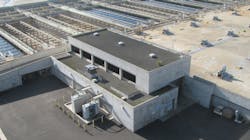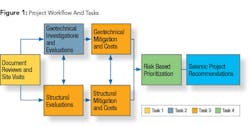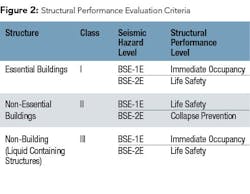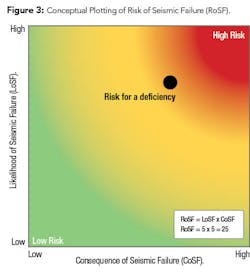Seismic Evaluation
Resiliency is a major concern for the stewards of wastewater infrastructure, and this is particularly true for Southern California’s Orange County Sanitation District (OC San). Located 30 miles southeast of Los Angeles in a seismically active region, OC San provides wastewater collection, treatment, and disposal services for approximately 2.6 million people. Because OC San’s facilities are exposed to seismic hazards, the potential for earthquake damage and associated service disruptions is a significant threat to their $11 billion infrastructure.
Earthquake Dangers: Strong Shaking and Soil Liquefaction
OC San provides wastewater treatment services at two treatment plants. Plant No. 1 is located in Fountain Valley, along the Santa Ana River, and has an average inflow of 120 MGD. Plant No. 2, located along the Santa Ana River in Huntington Beach, has an average inflow of 65 MGD.
Numerous active faults contribute to the region’s seismic risk and include the Newport-Inglewood and San Andreas Faults, each capable of producing earthquakes of magnitude 7.0 or greater. Such earthquakes can cause severe structural damage through ground shaking and through ground deformation that results from soil liquefaction and lateral spread.
Furthermore, both plants are near the Santa Ana River and are underlain by alluvial soils that are susceptible to liquefaction, a phenomenon in which water-laden soil liquefies when shaken hard enough, potentially resulting in large-scale settlement. Lateral spread can also manifest where liquefaction occurs in conjunction with a sloping site grade, which typically occurs along riverbanks.
Resiliency Study
Many structures at OC San’s treatment plants were built prior to the year 2000, using building codes that generally used lower estimates of seismic ground motion and did not adequately recognize the potential for seismic-induced ground deformations. With this realization, in 2017, OC San organized a team comprised of Geosyntec Consultants, Carollo Engineers, and Infraterra, and proactively completed a resiliency study to evaluate the utility’s treatment facilities for potential seismic hazards and to develop mitigation strategies to improve operational resiliency. A total of 63 structures (34 at Plant No. 1 and 29 at Plant No. 2) were evaluated. These included process buildings, operations facilities, basins, and tanks constructed with varying materials (concrete, masonry, steel), as well as foundation systems comprised of shallow footings and driven piles.
The study was conducted with four main tasks:
- Gathering information on the existing structures.
- Performing geotechnical investigation and evaluations.
- Performing structural evaluations and developing geotechnical and structural mitigation measures.
- Performing risk-based prioritization.
Relevant background data, including record drawings and historical geotechnical information, was reviewed to identify data gaps and additional data needs. Field visits were conducted to validate background data and to visually inspect the integrity of structural systems.
Geotechnical Investigations and Evaluations
Geotechnical investigations were conducted to construct a stratigraphic model for each plant to support evaluation of geo-seismic hazards. Soil borings and cone penetration test (CPT) data from previous investigations were reviewed to identify data gaps. To supplement the existing background information, six soil borings and 28 cone penetration tests were advanced to ground depths ranging from 65 to 100 feet. The soil data and other site characteristics were used to estimate liquefaction-induced differential settlements and lateral spreading deformations.
Ground motions were developed at each plant for two earthquake hazard levels having a 20 percent and 5 percent probability of exceedance in 50 years, which are referred to as the BSE-1E and BSE-2E seismic hazards, respectively. These earthquake hazard levels correlate to a lower level shaking hazard that is more likely to occur during the life of the structure and a higher-level shaking hazard that is infrequent and far less likely to occur. Additional geotechnical parameters integrated into the structural evaluation included bearing capacities, pile/soil anchor capacities, soil stiffness, differential settlement patterns, lateral spread estimates, and earth pressures.
Structural Evaluations
The team elected to use ASCE 41-13, a well-developed and widely accepted standard for the seismic evaluation of structures. Performance level goals were established consistent with ASCE 41-13 for each structure. These included immediate occupancy, life-safety, and collapse prevention. Immediate occupancy is a structure condition with minimal damage, thereby reducing the likelihood of service interruption. Life-safety is a condition with moderate damage necessitating repairs that may take several weeks to months before operation can be restored, but its performance is expected to maintain life-safety to occupants. Collapse prevention is a condition where the structure has sustained severe damage but does not collapse; the structure would no longer be serviceable and would require replacement, potentially taking years to restore service. Structures were evaluated at two hazard levels to estimate whether the defined performance levels could be met. OC San identified the required structural performance levels based on the relative importance of each structure within the system.
The ASCE 41-13 standard is flexible and intuitive, allowing the team to extend its use to non-building structures, such as tanks. It has a three-tiered approach to facilitate an efficient evaluation process:
- Tier 1 is a screening phase that includes checklists for various building types. Checklist statements are determined to be Compliant, Non-compliant, Not applicable, or Unknown.
- Tier 2 is a targeted evaluation with more in-depth structural analysis of non-compliant Tier 1 statements.
- Tier 3 is a systematic where the entire structure is analyzed using finite element software. Tier 3 was performed to estimate structure response to ground deformations.
Because liquefaction and lateral spread were identified as potential hazards for most structures in the study, and because ASCE 41-13 requires a Tier 3 analysis to evaluate response to ground deformation, an efficient approach was needed. Structures were organized into ten groups with similar structural characteristics. An exemplar representing each group was then selected for Tier 3 analysis. Exemplar structures were evaluated for various patterns of differential settlement. Findings for the exemplars were then compared qualitatively to their subsidiaries.
Calculating and Prioritizing Risk
Task 4 involved calculation of risk for each structure to prioritize mitigation. First, the team estimated a relative likelihood of seismic failure (LoSF) for each potential deficiency and assigned a score ranging from 1 to 5. Scores are relative to the degree to which the failure mode is deficient.
Second, a consequence of seismic failure (or CoSF) score was then assigned for each deficiency. The team considered six consequences and assigned a score of 1 to 5 for each. Consequences to life safety, primary treatment, and cost, among others, were considered. Scores for each consequence were proportionately related to the overall impact assuming failure occurs. Scores were also weighted to reflect relative importance, with life safety and primary treatment having the heaviest weighting. A governing CoSF score was then determined as the maximum score from each consequence.
Finally, the risk of seismic failure, or risk score, for each structure was calculated and defined as the LoSF x CoSF (see Fig. 3). The highest risk score for each structure was then prioritized — the higher the risk score, the higher the priority.
Conclusion
By evaluating seismic risks, including liquefaction and lateral spread, OC San was able to build a prioritized listing of mitigation recommendations to promote seismic resiliency. The utility now has a list of assets with an associated risk analysis that can be referenced as additional data when planning capital improvement projects. This information was instrumental in developing the budget, scope and schedule for five new projects added to OC San’s 10-year capital program to systematically improve the seismic resilience of its facilities.
In addition to considerations of physical condition and process viability, knowledge of seismic risk can also be used to help select asset management strategies, such as rehabilitation or replacement. The identified deficiencies also provide a list that can be used to prioritize post-earthquake condition assessments.
Preparing for major earthquakes before they occur is an important and necessary planning step in helping to secure service to the general public. Resilient facilities can protect communities against devastating damage to the environment and economic well-being with proper preparation. Seismic evaluation studies can help operators with their planning efforts to achieve resilient performance, in turn helping them fulfill their commitments to providing essential services to, and protecting the environment of, the communities they serve. WW
About the Authors: James Doering, P.E, S.E. is a structural engineer with Carollo Engineers. He has over 26 years of structural engineering experience and currently serves as Carollo’s chief structural engineer. He regularly leads seismic evaluation studies for clients throughout the Western United States, evaluating treatment plants and infrastructure that includes process buildings, basins, tanks, pump stations, and reservoirs. He was the lead structural engineer for the OC San seismic evaluation project described in this article.
Chris Conkle, P.E., G.E. is a geotechnical engineer with Geosyntec Consultants. He has over 17 years of experience in geotechnical engineering and project management. He was the project manager for the OC San seismic evaluation project described in this article.
Don Cutler is an Engineering Supervisor with the Orange County Sanitation District in Southern California. He oversees civil and mechanical design for the Sanitation District’s capital improvement program as it relates to their wastewater treatment facilities.
About the Author

James Doering
James Doering, P.E, S.E. is a structural engineer with Carollo Engineers. He has over 26 years of structural engineering experience and currently serves as Carollo’s chief structural engineer. He regularly leads seismic evaluation studies for clients throughout the Western United States, evaluating treatment plants and infrastructure that includes process buildings, basins, tanks, pump stations, and reservoirs. He was the lead structural engineer for the OC San seismic evaluation project described in this article.

Chris Conkle
Chris Conkle, P.E., G.E. is a geotechnical engineer with Geosyntec Consultants. He has over 17 years of experience in geotechnical engineering and project management. He was the project manager for the OC San seismic evaluation project described in this article.

Don Cutler
Don Cutler is an engineering supervisor with the Orange County Sanitation District in Southern California. He oversees civil and mechanical design for the Sanitation District’s capital improvement program as it relates to their wastewater treatment facilities.



